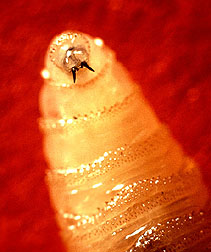This page has been archived and is being provided for reference purposes only. The page is no longer being updated, and therefore, links on the page may be invalid.
|
|
New Kit to Identify Tissue-Invading Fly MaggotsBy Jan SuszkiwJanuary 16, 2001 Screwworm flies, trying to sneak back into the United States, can be identified using a new diagnostic field kit developed by Agricultural Research Service scientists. Using the kit reduces, from several days to a few hours, the time it takes to differentiate screwworm fly maggots from similar fly species and take action to contain them, according to Steve Skoda, a screwworm researcher at ARS’ Midwest Livestock Insects Research Unit, Lincoln, Neb. Skoda’s lab developed the kit to support the Animal and Plant Health Inspection Service (APHIS), which coordinates current screwworm eradication programs in Central America. Agdia, Inc., of Elkhart, Ind., is collaborating with ARS to commercialize the technology. Both ARS and APHIS are agencies of the U.S. Department of Agriculture. Screwworms can harm or kill livestock, pets and people by feeding on living tissue at open wounds. Eradication programs have eliminated the parasite from the U.S., Mexico and most of Central America. Trade and travel to and from screwworm-infested regions like South America make re-infestations a concern. APHIS protocols for containing U.S. outbreaks involve the sterile insect technique (SIT). This approach calls for releasing sterilized male screwworm flies to mate with females in the wild. No eggs hatch, so the wild population collapses. In cases where only a few screwworms are detected, such as on imported cattle, insecticides and quarantine procedures may be used. With the new test kit in hand, a veterinary officer could confirm a suspected screwworm’s identity in six hours rather than ship it to a lab for visual examination. The kit, 99.9% accurate, turns blue when a specimen is a screwworm. Speed and accuracy are critical to choosing and applying the appropriate responses to suspected outbreaks. This includes coordinating costly sterile fly releases. The kit’s accuracy hinges on a monoclonal antibody that binds with a protein antigen in screwworm tissue samples. Skoda’s lab and University of Nebraska graduate James Lester Figarola discovered the protein. A commercial test kit could be available within two years, according to Agdia. Scientific contacts: Steven R. Skoda, ARS Midwest Livestock Insects Research Unit, Lincoln, Neb., phone (402) 437-5267, fax (402) 437-5260, sskoda@unlnotes.unl.edu. Willye W. Bryan, Insect Diagnostics Manager, Agdia, Inc., Elkhart, Ind., phone (219) 264-2014, fax (219) 264-2153, wbryan@agdia.com. |

